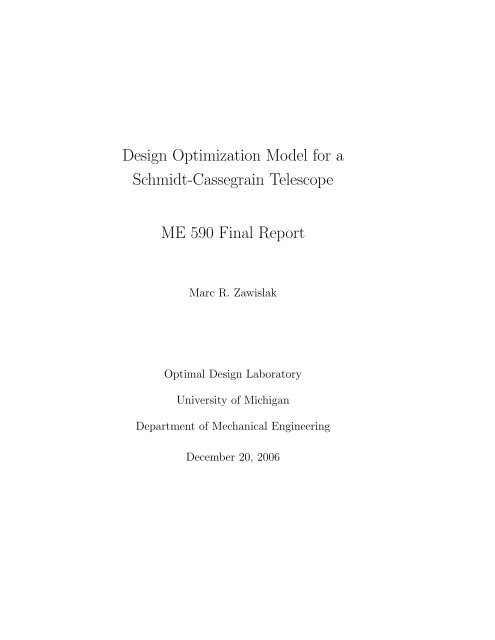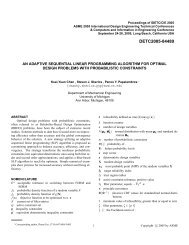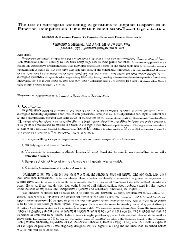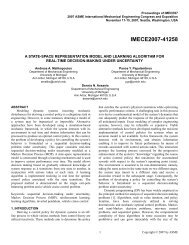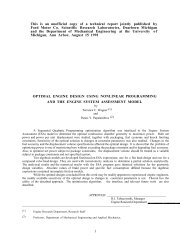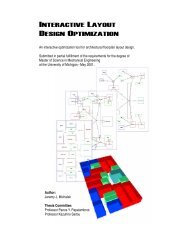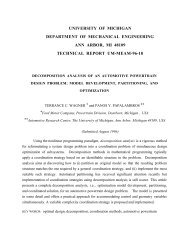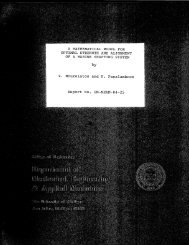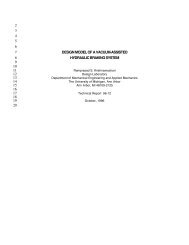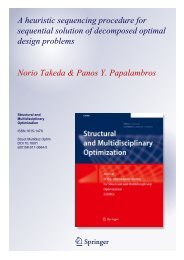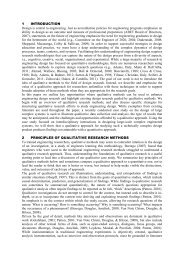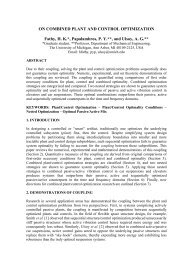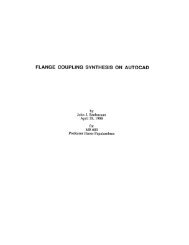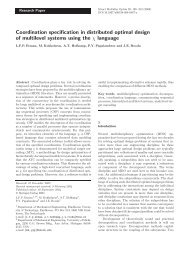Design Optimization Model for a Schmidt-Cassegrain Telescope ME ...
Design Optimization Model for a Schmidt-Cassegrain Telescope ME ...
Design Optimization Model for a Schmidt-Cassegrain Telescope ME ...
Create successful ePaper yourself
Turn your PDF publications into a flip-book with our unique Google optimized e-Paper software.
<strong>Design</strong> <strong>Optimization</strong> <strong>Model</strong> <strong>for</strong> a<strong>Schmidt</strong>-<strong>Cassegrain</strong> <strong>Telescope</strong><strong>ME</strong> 590 Final ReportMarc R. ZawislakOptimal <strong>Design</strong> LaboratoryUniversity of MichiganDepartment of Mechanical EngineeringDecember 20, 2006
Chapter 1AbstractThe goal of this project is to create a medium-sized multidisciplinary design optimizationmodel that displays strong interactions in-between design variables. Thismodel will be inputted into an automated coordination composition method that willshow the tradeoffs of decomposing the problem in different arrangements.A telescope product is used <strong>for</strong> the model. The telescope model chosen <strong>for</strong> thisapplication is a consumer telescope consisting of two mirrors and a lens that anamateur astronomer could build.The telescope model includes several different disciplines. First, the optics disciplineis represented through a ray-tracing program which takes the system componentsand predicts the first-order and third-order optics. Next, a thermal subsystemrepresents the thermal displacement of several telescope parts as they are exposedto different thermal environments. Then, the per<strong>for</strong>mance of the system with manufacturingtolerances of several parts is examined with a cost model of the materialsand manufacturing tolerances were developed to help show the ’price’ <strong>for</strong> using morematerials or tighter manufacturing tolerances. Finally, the tripod structure holdingthe telescope is modeled. The tripod is designed not to buckle, be tipped over easily,or easily clamp the telescope in position.In conclusion the model has many different disciplines which should be able to bedecomposed in different arrangements, thus showing the advantages of the optimaldecomposition method.1
Chapter 2NomenclatureVariable Description Unitst tube Thickness of the tube mD legs Diameter of the tripod legs mL legs Length of the tripod legs mD sch Diameter of <strong>Schmidt</strong> corrector and primary stop mD 1 Inner Diameter of tube and primary mirror mD 3 Diameter of secondary mirror mα tripod Tripod angle with ground radZ sch Length of outside edge of schmidt corrector to primary mirror mɛ 1ɛ 2Eccentricity of primary mirrorEccentricity of secondary mirrorZ mirrors Location of secondary mirror mR 1 Radius of curvature of the vertex of primary mirror mR 2 Radius of curvature of the vertex of secondary mirror mv Vertex of Back Focus mZ pivot Location of the pivot from primary mirror mh Baffle optimization free parameter m2
tol Zsch Tolerance of location of schmidt corrector mtol Zmirrors Tolerance of location of secondary mirror mtol R1 Tolerance of radius of curvature of primary mirror mtol R2 Tolerance of radius of curvature of secondary mirror mtol ɛ1 Tolerance of eccentricity of primary mirror mtol ɛ2 Tolerance of eccentricity of secondary mirror mg Acceleration of gravityms 2ρ tubeDensity of the tubekgm 3t mirror Thickness of the mirror mρ mirrorρ legsρ schDensity of the mirrorsDensity of the tripod legsDensity of the schmidt correctorkgm 3kgm 3kgm 3CR tube Cost of material of outer tube$m 3CR schACR schBCR mirrorACR mirrorBA coefficient of cost of material of <strong>Schmidt</strong> correctorB coefficient of cost of material of <strong>Schmidt</strong> correctorA coefficient(slope) of cost of material of mirrorsB coefficient(y-intercept) of cost of material of mirrorsCR legs Cost of material of tripod legs$m 3α thermaltube Thermal coefficient of expansion of tube1◦ Cα thermalmirror Thermal coefficient of expansion of mirror1◦ C∆T Temperature change Cd plo Nominal thickness of the plate mnumraysNumber of rays <strong>for</strong> ray-tracingE legs Young’s Modulus of tripod leg material Pa3
CRA slotCRB slotCRA stampCRB stampA cost coefficient of slotting manufacturingB cost coefficient of slotting manufacturingA cost coefficient of stamping manufacturingB cost coefficient of stamping manufacturingAiry Airy disk diameter mtime move Time to move the telescope a specified distance sF humanmax Minimum <strong>for</strong>ce that can be exerted in moving the telescope Nmax deadraysratioMaximum ratio of dead rays/total raysF human Force human exerts on telescope during accident Ntime human Time the human exerts the <strong>for</strong>ce on telescope during accident sMaxCost material Maximum cost of materials $MaxCost tolerance Maximum cost of the tolerancing $FMaximum F ocal# max #FMinimum F ocal# min #range <strong>for</strong> <strong>Schmidt</strong>-<strong>Cassegrain</strong>range <strong>for</strong> <strong>Schmidt</strong>-<strong>Cassegrain</strong>τ max Maximum clamping torque that can be applied N − mtol per<strong>for</strong>mPercentage of objective the tolerance limits must be withinV ert Llegs Vertical height of tripod legs mq Off-axis distance <strong>for</strong> spot diagrams mw Angular Field of View radˆm 2δS ∗ IInteger in definition of characteristic function of SCTContribution of an aspheric plate to third order aberrations4
Chapter 3Introduction to <strong>Telescope</strong>sA telescope model was used to help demonstrate the objective of this project. Thischapter gives an overview of the telescope system, their optics and examples of typesof telescopes used my amateurs.3.1 The <strong>Telescope</strong> SystemA telescope product was initially chosen <strong>for</strong> the model. <strong>Telescope</strong>s can vary in sizefrom a set of binoculars to the world’s largest telescope in Mauna Kea, Hawai’i withmirrors 10 meters in diameter. Not only varying in size, telescopes can vary incomplexity from a single lens to compound systems which are a combination of multiplemirrors and lenses. <strong>Telescope</strong> optics’ origin dates back to the early seventeenthcentury being studied by professional optical designers. Until recently, amateur astronomershave not been involved in the telescope design process. However, with thedevelopment and availability of optical computer programs amateurs have been moreinterested in becoming involved in this process. Thus, this project will focus on atelescope that an amateur is capable of building.An amateur telescope design can consist of designing many different parts. First,two types of optics devices can be included in telescopes: reflecting and refractingdevices. Refracting devices change the velocity of the light while it is traveling throughthe medium. This causes the light rays to exit the medium at a different angle thanentry. Since, different colored light travels at different wavelengths, the refractiveangle varies with different colors. An example of a refracting device is a prism whichdisperses the rainbow as white light enters. A reflecting device is different from arefracting object as it does not allow the visible image to pass through it. Instead, itbounces back the image in the direction of its source at a different angle. An exampleof a reflecting device is a mirror.A telescope system includes much more than just the lens and mirrors. First, atube encloses its contents to protect the quality of the optical devices and holds them5
in place. Next, telescopes include an eyepiece which enables the astronomer to beable to examine the image <strong>for</strong>med from the mirrors and lens. However, the eyepieceis so specialized that designing one in detail is another project in itself. Aroundeach mirror, baffles are set up to help prevent stray light that is not desired by theastronomer to enter the eyepiece. These baffles can be compared to blinders that areput on a horse be<strong>for</strong>e a race to make sure they focus on the objective. Furthermore, astructure must hold the telescope in place to allow stationary viewing and stability. Inmost portable consumer telescopes, a tripod structure consisting of three legs securesthe telescope in place. The tripod can prevent someone from easily knocking thetelescope over or the wind causing vibrations while star gazing. Finally, there aremany other smaller parts within a telescope that can be explained, however these arethe main parts used in the telescope model. All of the main parts highlighted in thischapter will be discussed in more detail in our model analysis.3.2 <strong>Telescope</strong> OpticsFirst order optics is a term concerning the optical analysis of rays with terms in thefirst order. This term describes how the light rays move within the desired mediums ina two-dimensional analysis. First order optics can be applied to a ray-tracing programto help examine the third order optics. Ray-tracing follows the rays algebraically asthey are reflected or refracted throughout the telescope system. In this model thefirst order analysis is completed through a ray-tracing algorithm.Third order optics is a term about image aberrations with optical terms in thethird order. There are two types of aberrations: chromatic and monochromatic.Monochromatic aberrations are present in both refracting and reflecting systems andare not contingent of the wavelength. Monochromatic aberrations include: sphericalaberration, coma, astigmatism, curvature of field, and distortion, which will explainedin more detail in further sections. These aberrations can be measured analyticallythrough a set of equations. Next, chromatic aberrations are present in refractiveelements because the refractive index of glass is contingent on the wavelength. Anexample of this type of aberration can be witnessed in colors dispersing in a prism.Chromatic aberrations can be displayed through a series of plots called spot diagramswhich is shown in figure 3.1. These spot diagrams will be used as our basis todetermine the extent of the chromatic aberrations.3.3 Types of Amateur <strong>Telescope</strong>sMany different telescopes have been created throughout the four century long history.Two of the more popular reflective amateur telescopes and the most widely used6
Figure 3.1: Example of a Spot Diagramrefractive lens will be discussed briefly in this section.The Newtonian telescope is one of the simplest and most popular telescopes <strong>for</strong>amateur astronomers. The Newtonian telescope consists of two mirrors, a paraboloidalprimary mirror and a flat secondary mirror as shown in figure 3.2. The focal surfacewhere the astronomer views the image is above the tube. The secondary mirror centrallyblocks light from traveling to the primary mirror. However, since the secondarymirror is at an angle it does not obstruct as much light as other telescopes. Un<strong>for</strong>tunately,by itself the telescope design suffers from monochromatic aberrations andother devices must be inserted to reduce these aberrations.The <strong>Cassegrain</strong> telescope is another very popular telescope <strong>for</strong> amateur astronomersto build. The telescope is fairly similar to the Newtonian with two mirrors, howeverthe focal surface is in back of the tube as compared with above <strong>for</strong> the Newtonian asshown in figure 3.3. In addition, both mirrors in a <strong>Cassegrain</strong> are spherical. Similar7
Figure 3.2: Optical Layout of Newtonian <strong>Telescope</strong>to the Newtonian, the central obstruction causes a large loss of contrast and imagesharpness. However, reducing the size of the secondary mirror can cause an increasein aberrations. Thus, the designer must review the tradeoffs of loss of light and thepresence of aberrations in a <strong>Cassegrain</strong> system. Unwanted light can easily make itsway into the focal area of a <strong>Cassegrain</strong> system, thus baffles must be introduced toblock stray light. However, this further increases the loss of light entering the eyepiece.Figure 3.3: Optical Layout of <strong>Cassegrain</strong> <strong>Telescope</strong>The <strong>Schmidt</strong> corrector is an aspheric refraction lens inserted to help reduce monochromaticaberrations with spherical mirrors. The profile of a <strong>Schmidt</strong> corrector dictateshow the rays are refracted through the profile. However, since the corrector is arefracting element, it creates chromatic aberrations which can be measured throughspot diagrams. The corrector lens is usually an addition to a telescope with a reflectivesurface.The telescope type that will be modeled in this paper is a <strong>Schmidt</strong>-<strong>Cassegrain</strong>telescope(SCT). This is a very popular telescope among astronomers due to its compactness,transportability and excellent reduction of chromatic aberrations. The SCTcombines the <strong>Cassegrain</strong> telescope with a <strong>Schmidt</strong> corrector <strong>for</strong> a total of three op-8
tical components as shown in figure 3.4. The location of these components are freewhich gives a large design space <strong>for</strong> the designer. The SCT system consists of twostrongly curved mirrors <strong>for</strong> our model. In addition, the <strong>Schmidt</strong> corrector helps reducethe about of loss light with respect to the traditional <strong>Cassegrain</strong> telescope. Thissystem will give us a very interesting optimization model as many different objectsand disciplines rely on the same design variables of the system.Figure 3.4: Optical Layout of <strong>Schmidt</strong>-<strong>Cassegrain</strong> <strong>Telescope</strong> without BafflesThe next chapter will explain the <strong>Schmidt</strong>-<strong>Cassegrain</strong> telescope model. It willgive an overview of the telescope and the model <strong>for</strong> each of the discipline subsystemscreated <strong>for</strong> this model.9
Chapter 4<strong>Schmidt</strong>-<strong>Cassegrain</strong> <strong>Telescope</strong>This chapter provides detail on the <strong>Schmidt</strong>-<strong>Cassegrain</strong> telescope algorithm and providesan overview of the analysis methods employed in this model.4.1 <strong>Schmidt</strong>-<strong>Cassegrain</strong> <strong>Telescope</strong> SystemThe <strong>Schmidt</strong>-<strong>Cassegrain</strong> <strong>Telescope</strong>(SCT) is a very popular telescope to amateur astronomers.It consists of two mirrors and a refractive medium, a <strong>Schmidt</strong> corrector.Due to the number of parts, the design space or configurations of the telescope canvary. This will give a more interesting design problem as there is a large amount ofspace to examine.Figure 4.1 is a picture of the <strong>Schmidt</strong>-<strong>Cassegrain</strong> telescope with our dimensioningof the design variables of the telescope. From this figure, all of the design variablesthat deal with the telescope and the baffle coordinates are shown in the z-y plane.It can be noted that zero of the z-axis begins at the location of the primary mirrorand the zero of the y-axis is at the center line and the x-plane goes into the paper.Also, the centerline shows that the system is symmetrical. The dimensioned tripodcan be found in figure 4.6. From the diagram, several geometric constraints can bedetermined. First, the length from the primary mirror to the <strong>Schmidt</strong> corrector mustbe greater than to the secondary mirror as shown in equation 4.1. Also, the innerdiameter of the tube is defined to be the diameter of the primary mirror. Thus, thediameter of the aperture stop and <strong>Schmidt</strong> corrector must be less than that or itwould be protruding through the tube as shown in equation 4.2.Z sch ≤ Z mirrors (4.1)D 1 ≥ D sch (4.2)The model comprises of several disciplines of the <strong>Cassegrain</strong>-<strong>Schmidt</strong> system.10
Figure 4.1: Dimensioned Drawing of <strong>Schmidt</strong>-<strong>Cassegrain</strong> <strong>Telescope</strong>First, the optics discipline is represented through a ray-tracing program which takesinto account the corrector lens and two mirrors and predicts the first-order and thirdorderoptics. Next, a thermal subsystem represents the thermal displacement ofseveral telescope parts as they are exposed to different thermal environments. Next,the per<strong>for</strong>mance of how the system reacts to the bounds of manufacturing tolerancesof several parts is examined.with a cost model of the materials and manufacturingtolerances to show the ’cost’ <strong>for</strong> using more materials or tighter manufacturing tolerances.Finally, the tripod structure holding the telescope is modeled. The tripodis designed not to buckle, be tipped over easily, or easily clamp the telescope in position.All of these disciplines can be combined into one system to determine the trueoptimal design of the telescope.4.1.1 Description of Objective FunctionThe objective function of system is to minimize the aberrations. The aberrationsare viewed by the astronomer as a blurred image and can be caused by a varietyof reasons. A visual method to view these aberrations are through a series of spotdiagrams. An example of spot diagrams is shown in figure (reference) where each dotrepresents a single ray. The spot diagrams display what the image would look likeat different off-axis distances and wavelengths. For visual use, the spread of the dotsmust be within a very small circle. The circle in which the light must encompass canbe measured through an Airy disk which includes 84% of the energy in the image [6].11
Thus, the Airy Disk will include the majority of the intensity of the image. The Airydisk is a function of the focal ratio of the system as shown in equation 4.3. Thus, theobjective of the system is to minimize the amount of rays that are outside of the Airydisk <strong>for</strong> each of the spot diagrams. A penalty function <strong>for</strong> ray’s distance away fromthe center was calculated to keep the objective continuous. Essentially, a ray withinthe Airy disk will be given a score of around zero and a ray outside the Airy diskwill be given a penalty as shown in equation 4.4. This penalty has a very steep slopearound the Airy disk boundary to simulate a discrete function as shown in figure 4.2where the limit is 0.05 m.Airy = 10 −6 F # + 5 ∗ 10 −7 (4.3)Φ(x, y, z, λ, q) =2000Airy100000(1 + e2 −spot(x,y,z,λ,q)) (4.4)Figure 4.2: Graph of Airy Disk Penalty FunctionThe objective function is calculated from a total of nine spot diagrams and shownbelow. The three different wave lengths are shown in table 4.1 and the three differentoff-axis distances are zero, 10, and 20 mm.minx3∑3∑numrays∑q=1 λ=1 rays=1subject to g(x) ≤ 0h(x) = 0Φ(x)12
Several equality and inequality constraints help limit the design bounds of thesystem. Most of the inequality constraints can be found throughout the model descriptionsin equations 4.1, 4.2, 4.7, 4.8, 4.34, 4.44, 4.50, 4.51, 4.52, 4.53 4.60, 4.62,4.77, 4.80, 4.81, 4.83 and 4.87. The equality constraints can be found through themodel descriptions in equations 4.18, 4.36, 4.37, 4.38, and 4.69.An important system per<strong>for</strong>mance parameter considered with all telescopes is thefocal ratio. The focal ratio is a ratio of the focal length of a mirror and the diameter ofthe aperture. It is a quantitative measure of the lens speed which is more importantin photography settings. In telescope settings, the focal length controls the scale ofthe image that is presented at the eyepiece. Most telescopes are designed with afocal ratio specified, however <strong>for</strong> our model the focal ratio will be calculated from theradius of curvatures of the mirrors and the separation in-between mirrors. From [8], arange of suitable focal numbers is given <strong>for</strong> a <strong>Schmidt</strong>-<strong>Cassegrain</strong> telescope and actsas a constraint on a system as shown in equations 4.7 and 4.8.1f ′ = −f ′ 2 + f ′ 1 − Z mirrorsf ′ 1f ′ 2(4.5)F# = f ′D sch(4.6)F# max≥ F #F# min≤ F #(4.7)(4.8)4.1.2 Ray-Tracing AlgorithmA ray-tracing algorithm is developed to determine what the image will look like <strong>for</strong> theastronomer through the eyepiece. Through the ray-tracing algorithm the objectivefunction and spot diagrams can be developed. Furthermore, the spot diagrams canvisually highlight any aberrations that are present in the system.The first step in setting up the ray-tracing algorithm is giving an initial position<strong>for</strong> the rays. Figure 4.3 shows the location of all of the initial rays in a concentricpattern. The program will allow you to enter in the number of rays to be traced and itwill develop the coordinates of each individual ray. Furthermore, all the coordinatesmust have three different wavelengths assigned to it. Furthermore, all the coordinatesmust have three different off-axis distances that will be used later in the ray-tracingprogram. In conclusion, <strong>for</strong> the coordinates of each ray there will be 3 2 differentcombinations that will be entered into the ray-tracing program as shown in our spotdiagram figure 3.1 <strong>for</strong> the same [x 0 , y 0 , z 0 ] coordinates.13
Figure 4.3: Concentric Initial Ray-Tracing PositionsThe ray-tracing program is a multi-step process to determine the final ray location.First, the actual ray-tracing algorithm was gathered from Terebizh [7]. Theactual equations will not be transcribed in this report, but they can be found inthe referenced paper. However, several changes and additions must be made to thisray-tracing algorithm. First, the algorithm is <strong>for</strong> a cassegrain telescope and does nottake into account the <strong>Schmidt</strong> corrector. Thus, the next section describes the addition<strong>for</strong> the <strong>Schmidt</strong> corrector. Next, Ray Tracing Algorithm Additions describeswhat additions to the ray-tracing algorithm was added on. Finally, Baffle <strong>Design</strong> andAlgorithm describes how the baffle was designed and its impact on the ray-tracingalgorithm.<strong>Schmidt</strong> Corrector Ray TracingA <strong>Schmidt</strong> corrector was absent from the previously developed ray-tracing algorithm,thus it must be added in <strong>for</strong> our <strong>Schmidt</strong>-<strong>Cassegrain</strong> telescope. The <strong>Schmidt</strong> correctorwill change the angle of the ray as it travels toward the primary mirror. Since the<strong>Schmidt</strong> corrector is a refractor, different wavelengths from the same entrance locationwill exit the corrector at different angles. As shown in figure 4.4, the profile of a<strong>Schmidt</strong> corrector is an aspheric surface. wavefront aberration in terms of radianscan be expressed in <strong>for</strong> a corresponding refractive index n ′ 0 is shown in equation 4.9.n ′ 0 corresponds to a refractive index <strong>for</strong> wavelength λ 0 which is the benchmark, <strong>for</strong>our problem that will be the green wavelength. In addition, the new z-coordinateof our ray is going shown in equation 4.14 where 4.13 calculates the thickness of the<strong>Schmidt</strong> corrector.where(δW I ) 0 = 1 D sch512 N 3 (ρ4 pl − k pl ρ 2 pl) (4.9)N = −f ′ 1D sch(4.10)14
ρ pl =yD sch2(4.11)k pl =y2( D sch2 )2 (4.12)d pl = 1512 ( 1n ′ 0 − 1 )D schN 3 (ρ4 pl − k pl ρ 2 pl) + (d pl ) 0 (4.13)Z 1 = Z sch − d pl (4.14)Figure 4.4: Profile of the <strong>Schmidt</strong> CorrectorEquation 4.15 determines the chromatic differential wavefront error <strong>for</strong> a givenwavelength λ 1 and refractive index n ′ 1. The three wavelengths and their refractiveindexes in BK7 glass can be found in table 4.1. From the <strong>Schmidt</strong> corrector analysis,the angle and position of the ray entering the primary mirror can be calculated andadded to the ray tracing algorithm.(δW I ) 1 = n′ 1 − 1n ′ 0 − 1 (δW I) 0 (4.15)Ray-Tracing Algorithm AdditionsAs mentioned be<strong>for</strong>e the ray-tracing program is very similar to Terebizh’s <strong>for</strong>mulation.However, some differences <strong>for</strong> our example was adopted to make the <strong>for</strong>mulationwork. First, the original <strong>for</strong>mulation is only is only in two dimensions, however our15
Table 4.1: Color, Wavelengths, and Refractive Index of BK7 GlassColor Wavelength (nm) Refractive IndexRed 656.27 1.51432Green 546.07 1.51782Blue 486.00 1.52238ray-tracing program is in three dimensions. To solve this, it was assumed that thelens and mirrors would be symmetrical throughout the entire telescope tube. Thus,the initial y-coordinate in the algorithm can be computed by the distance from thex 1 and y 1 coordinate of the ray entering the system as shown in equation 4.16. Next,the algorithm gives a y-coordinate <strong>for</strong> the final ray through the eye-piece, however itdoes not give an x-coordinate. To solve <strong>for</strong> the x-coordinate, it is assumed the raywill converge toward the zero of the x-coordinate at the same rate as the y-direction.Thus, equation 4.17 expresses this with x and y as the initial ray coordinates and x fand y f as the final ray coordinates.y 0 =√x 2 1 + y 2 1 (4.16)x f = y fxy(4.17)Baffle <strong>Design</strong> and AlgorithmA baffle system was designed in our system to help reduce stray light entering thetelescope. The baffle system goal is to eliminate all the direct stray light entering thesystem without limiting the contrast and resolution of the object you are trying toview. Terebizh [7] has a optimal baffle algorithm which was used <strong>for</strong> this project. Allthe notation was taken directly that paper to reduce confusion. The only change isthat the paper’s x-coordinates are z-coordinates in this report. From Terebizh, thecoordinates of the baffle design can be inputted into our system. Finally, one systemequality constraint must be added to ensure the optimal baffle is designed as shownin equation 4.18.ρ baf (h) = [(Z 3 − Z 2 ) 2 + (Y 3 − Y 2 ) 2 ] 1 2 = 0 (4.18)An algorithm must be developed to determine when the rays will intersect thebaffle and not make it to the eyepiece. There are five different ways in which a raymay ”die” and not make it into the eyepiece. In the programming, the ray must pass16
all of the checkpoints to be deemed that it makes it to the eyepiece. A diagram ofthese scenarios can be found in figure 4.5Figure 4.5: Scenarios of Rays Blocked by BafflesCase #1 is if the ray hits the back of the secondary mirror. If the secondary mirroris too large it will prevent the rays from hitting the primary mirror and entering theeyepiece. To calculate this, we determined the y-position of the ray at z=Z mirrors . Ifthe position was less than half the diameter of the secondary mirror then then theray is eliminated. In conclusion if equation 4.19 is true, then the ray is eliminated.b − tan α ≤ D 3(4.19)2Case #2 is that the ray hits the baffle attached to the secondary mirror be<strong>for</strong>ehitting the primary mirror. A line can be drawn from the secondary baffle corner tothe secondary mirror with the slope of m 1 and y-intercept of b 1 . It is assumed thecurvature in the secondary mirror in the z-direction is negligible. Thus, the algorithmdetermines when the line of the ray will intersect with the line of the secondary baffleat pos 2 . Then, if the position is in-between the start or end-position of the baffle thenthe intersection is real and the ray will be eliminated, if it is not in-between thenthe intersection will not occur. In conclusion, if equation 4.21 is true, then the ray iseliminated.m 1 = (Y 3 − D 32)(Z 3 − Z sch )(4.20)b 1 = Z 3 − m 1 Y 3 (4.21)17
pos 2 = (b − b 1)(m 1 − µ)(4.22)Z 3 ≥ pos 2 ≥ Z mirrors (4.23)Case #3 is that the ray hits the primary mirror, then hits the baffle attached tothe secondary mirror be<strong>for</strong>e hitting the secondary mirror. Similar to the past twoexamples, a line is drawn from the secondary baffle corner to the secondary mirrorwith m 1 and b 1 . The equation of the line coming off the primary mirror is known. Thealgorithm determines when the line of the ray will intersect the line of the secondarymirror. If the intersection occurs within the coordinates of the baffle then the raywill be eliminated. Thus, if equation 4.25 is true, then the ray will be eliminated.pos 3 = (a − b 1)(m 1 + k)(4.24)Z 3 ≥ pos 3 ≥ Z mirrors (4.25)Case #4 is that the ray hits the primary mirror, then hits the baffle attached tothe primary mirror. This was calculated similarly to the past examples. However,now the ray must hit the primary baffle instead of the secondary baffle. The baffleattached to the primary mirror is described with a slope of m 2 and y-intercept of b 2 .Finally, if equation 4.29 is true, then the ray will be eliminated.m 2 = (Y 1 − Deye2 )Z 1(4.26)b 2 = D eye2pos 4 = (a − b 2)(m 2 + k)(4.27)(4.28)Z 1 ≥ pos 4 ≥ 0 (4.29)Case #5 is that the ray hits the primary mirror and secondary mirror, then hits thebaffle on the primary mirror. If equation 4.33 is true, then the ray will be eliminated.m 3 = (Y 2 − l 2 )(s 2 − v)(4.30)b 3 = y 2 − m 3 s 2 (4.31)pos 4 = (b 2 − b 3 )(m 3 − m 2 )(4.32)18
Z 1 ≥ pos 4 ≥ −v (4.33)A count of all the rays that are eliminated is kept which is a per<strong>for</strong>mance criteria.Equation 4.34 calculates the ratio of rays that are eliminated with respect to the totalnumber of rays. From [5], it is noted that the number of rays that are eliminatedshould be no more than 30% as represented by the parameter max deadraysratio .4.2 Third-Order Aberrationsdeadraysrays total≤ max deadraysratio (4.34)Aberrations within the system lead to reduced optical quality. An ideal optical systemwould produce a point image <strong>for</strong> the astronomer’s eyes if the source was a star.However, is most cases a blurred circle is obtained where it is a combination ofdifferent kinds of aberrations. As explained earlier, there are two types of aberrations:chromatic and monochromatic. Chromatic aberrations are a function of the colorof light or wavelength of the light entering in the system.While monochromaticaberrations will be the same <strong>for</strong> all types of wavelengths entering in the system. Thefollowing sections will discuss chromatic and monochromatic aberrations and howthey are calculated <strong>for</strong> our model.4.2.1 Chromatic AberrationsChromatic aberrations occur in refracting light as a function of the specific wavelength.Chromatic aberrations cannot be solved analytically like monochromaticaberrations. Thus, they can be viewed as spot-diagrams with varying wavelengthsand off-axis angles. The spot-diagrams is the objective function and can be describedin section 4.1.1.4.2.2 Monochromatic AberrationsMonochromatic aberrations occur in both refracting and reflecting with respect toone wavelength. The Seidel aberrations were developed in the 1850’s where ΣS Ideals with spherical aberration, ΣS II is coma, and ΣS III is astigmatism from [8].For all of the necessary aberrations to be eliminated they must all be equal to zeroas shown in equation 4.35. Equations 4.36, 4.37 and 4.38 are equality constraintsthat will eliminate all of the monochromatic aberrations. The spherical aberration,coma and astigmatism are represented by equations 4.36, 4.37 and 4.38 respectively.Finally, equation 4.44 limits the necessary asphericity <strong>for</strong> the aspheric plate withrelation to the focal length of the primary mirror and is a system inequality.19
ΣS I = ΣS II = ΣS III = 0 (4.35)−f ′ ζ + Lξ + δS ∗ I = 0 (4.36)−d 1 ξ − −f ′2 + s plf ′ δS∗ I = 0 (4.37)wheref ′L (f ′ + d 1 ) + d2 1L ξ + (s plf ′ )2 δS ∗ I = 0 (4.38)ξ = ( ˆm 2 + 1) 3( ˆm 2 − 14 ˆm 2 + 1 )2 (4.39)ζ =ˆm 2 24(1 − ɛ 2 1)(4.40)d 1 = Z mirrors (4.41)L = v − Z mirrors (4.42)s pl = −Z s chf ′ (4.43)δSI ∗ ≤ −f 1′ (4.44)4It must be noted that it might be very difficult to satisfy all three of the equalityconstraints. Baker [8] proposed that only four different SCT configurations can bedevised to eliminate all three aberrations which would greatly reduce the design space.Thus, it might suggested to relax these equality constraints to inequality constraintswith some slack to create a more interesting design problem.4.3 Thermal DisplacementThe telescope can be used in different temperature environments which will effect theper<strong>for</strong>mance. Thermal expansion or compression will result in misalignments of theparts and aberrations within the system. The system is designed <strong>for</strong> room temperature,however the telescope could be brought outside during a cold night or usedin very hot conditions. Thus, both cases must be investigated. Thermal displacementswere taken into account <strong>for</strong> the outside tube. This effected the positioning ofthe <strong>Schmidt</strong> corrector and secondary mirror. The displacements were added to themanufacturing tolerances explained in section 4.4.20
4.3.1 Thermal Displacement of TubeThe outside tube of the telescope will displace with changes to the temperature. Thiswill cause the components inside the tube to change their positions which will ineffect cause aberrations. In this section, we will measure how far the componentswill change positions as a function of temperature change. The effect of the changeson the per<strong>for</strong>mance will be calculated in the manufacturing tolerances in section 4.4.Equation 4.45 calculates the thermal elongation of the entire tube due to a change intemperature ∆T of 20 ◦ C. Equation 4.46 and 4.47 calculate the thermal displacement<strong>for</strong> position of the <strong>Schmidt</strong> corrector and secondary mirror.It was assumed thetube would be made out of Wrought Aluminum Alloy 7050, T7451 with a thermalexpansion (α thermaltube ) of 23.6 · 10 −6 1 ([1]). Finally, Since the primary mirror is at◦ Creference axis it is assumed it will stay at that position.δ tube = α thermaltube ∆T Z tube (4.45)δ sch = δ tubeZ SchZ tube(4.46)δ mirrors = δ tubeZ mirrorsZ tube(4.47)4.4 Manufacturing Tolerances and Cost <strong>Model</strong>ingThe manufacturing tolerances of the components in the system were taken into consideration.A system without tolerances is very unrealistic as the parts cannot bemanufactured and assembled to the exact dimensions they are specified. However toshow the tradeoffs of tighter tolerances, a cost model must be developed simulatingthe cost of increased tolerances. Thus, this section will explain the computation ofthe manufacturing tolerances and their respective cost model.4.4.1 Tolerances of MirrorThis section summarized how the per<strong>for</strong>mance is measured <strong>for</strong> the tolerances due tothermal displacement and manufacturing processes. First, the tolerances are considered<strong>for</strong> six design variables:(1) Eccentricity of the primary mirror (ɛ 1 )(2) Eccentricity of the secondary mirror (ɛ 2 )(3) Radius of curvature of the vertex of primary mirror (R 1 )(4) Radius of curvature of the vertex of secondary mirror (R 2 )(5) Location of the secondary mirror (Z mirrors )21
(6) Location of the <strong>Schmidt</strong> corrector (Z sch )The manufacturing processes to create each of these parts and design variableswere considered. It is assumed the <strong>Schmidt</strong> corrector and secondary mirror willplaced by a slotting action in the tube. Thus, from CES [1] the tolerances that canbe obtained <strong>for</strong> slotting is 0.00002 to 0.005 m. A stamping process will be cuttingout the material <strong>for</strong>ming the secondary and primary mirrors. Thus, the availabletolerances that can be obtained <strong>for</strong> stamping is from 0.0001 to 0.0008 m [1]. Next,the tolerances must be added when applied to the design variables and the telescope’sper<strong>for</strong>mance must be analyzed. In addition, the tolerances can include the thermaldisplacement that were calculated in section 4.3.1. As a function of the temperaturechange the material could expand or contract, thus the thermal displacement of thematerial is summed in the total toleranceThe per<strong>for</strong>mance of the telescope was analyzed <strong>for</strong> two different tolerance scenarios:the maximum positive and negative cases. The maximum positive case is whenall the design variables are at the tolerance bounds is the positive direction. Thenegative case is in the same line of thought except the tolerances are subtracted. Forexample, a part that is 1 ± 0.05. For the positive case, the part’s dimension would be1.05 while <strong>for</strong> the negative case the part’s dimension would be 0.95. Since, some ofthe design variables are already negative, the positive case would increase the lengthof the object, <strong>for</strong> example from -1 to -1.05. For the thermal displacement, the positivecase would be <strong>for</strong> thermal expansion while the negative case is <strong>for</strong> contraction. Thiscan be shown in equation 4.48 <strong>for</strong> the positive tolerances and 4.49 <strong>for</strong> the negativetolerances. It was concluded that this method would be able to examine the two extremesof the design space from the nominal value to both bounds of the tolerances.Possibly, a Monte Carlo simulation of the design space can determine if there are anytolerance combinations that reduce the per<strong>for</strong>mance more.ɛ 1hbound = ɛ 1 + tol ɛ1 + δ ɛ1 (4.48)ɛ 1lbound = ɛ 1 − tol ɛ1 − δ ɛ1 (4.49)The dimensions of the new toleranced design variable values and other designvariables are entered into the ray-tracing algorithm. So, the ray-tracing program iscalled three times in total, once with the nominal values and twice with the tolerancedimensions. From the ray-tracing program, a new penalty function value will becalculated <strong>for</strong> both tolerance scenarios which will be compared with the penalty valueof the nominal system. The positive and negative tolerance penalty values must bewithin a certain percent of the nominal objective function as shown in the constraints4.50 and 4.51. In addition, the number of rays what are eliminated by the bafflesmust be within the same range to ensure the sharpness as shown in equation 4.5222
and 4.53. These inequalities ensure that the toleranced model’s per<strong>for</strong>amnce criteriais within a certain percent nominal values.obj hbound ≤ tol per<strong>for</strong>m obj nominal (4.50)obj lbound ≤ tol per<strong>for</strong>m obj nominal (4.51)deadrays hboundrays total≤ tol per<strong>for</strong>m max deadraysratio (4.52)deadrays lboundrays total≤ tol per<strong>for</strong>m max deadraysratio (4.53)4.4.2 Cost <strong>Model</strong>ing of Manufacturing TolerancesA cost model of the manufacturing tolerances was developed to help show the tradeoffsof tighter tolerances.In addition, this <strong>for</strong>mulation will help prioritize whichdimensions will be allocated more money <strong>for</strong> tighter tolerances based on the opticalper<strong>for</strong>mance. It has been noted [2] that cost modeling <strong>for</strong> manufacturing tolerancescan be calculated in many different <strong>for</strong>mulations. The general cost <strong>for</strong>mulation of themanufacturing tolerances <strong>for</strong> this model is a reciprocal function and shown in equation4.54 where A and B are constants and T is the manufacturing tolerance of thedimension. Since, the manufacturing tolerances cost is site specific, a baseline costwas set up <strong>for</strong> one of the manufacturing processes and the other process was pricedwith respect to baseline.C m = A + B T(4.54)The cost of the manufacturing tolerances <strong>for</strong> the placement of the <strong>Schmidt</strong> correctorand secondary mirror were calculated similarly. In addition, this manufacturingprocess was used as the baseline <strong>for</strong> the other process to be compared with. Themanufacturing cost of slotting is calculated in equation 4.55 where CRA slot is equalto 1 and CRB slot is equal to 0.005. For the tolerance ranges of slotting, the cost ofproducing the tolerances is from $11 to $211 <strong>for</strong> each action. However, the tolerancescan be different <strong>for</strong> each of the two cutting components, thus total cost <strong>for</strong> slotting iscalculated within 4.59 where teh costs are a function of the tolerance of the positionof the <strong>Schmidt</strong> correcotr and secondary mirror.C slot = CRA slot + CRB slotT slot(4.55)C totslot = C slot (T Zsch ) + C slot (T Zmirrors ) (4.56)23
The cost of manufacturing the eccentricity and curvature of radiuses of the primaryand secondary mirror were calculated similarly. It was decided the stampingprocess would be more expensive than the slotting process <strong>for</strong> both the initial costand producing tighter tolerances. The manufacturing cost was calculated in equation4.57 where CRA stamp is equal to 10 and CRB stamp is equal to 0.05. For the rangeof tolerances <strong>for</strong> stamping, the cost of the tolerances range is $72.50 to $510. Thetolerances can be different <strong>for</strong> all four of the stamping components, thus the totalcost <strong>for</strong> cutting is calculated within equation 4.59.C stamp = CRA stamp + CRB stampT stamp(4.57)C totstamp = C stamp (T ɛ1 ) + C stamp (T ɛ2 ) + C stamp (T R1 ) + C stamp (T R2 ) (4.58)The total cost <strong>for</strong> allocating tolerances can be seen in equation 4.59. This takes intoaccount six different design variables that tolerances are allocated to. Finally, theconstraint in equation 4.60 limits how much money can be spent on precise tolerances.cost tolerance = C totslot + C totstamp (4.59)MaxCost tolerance ≥ cost tolerance (4.60)4.5 Material Cost <strong>Model</strong>ingA cost model of the materials used to build the telescope system was developed toshow the tradeoffs a consumer or company might go through in their decision makingmodel. The cost model takes into account the following parts of the telescope:(1) Outer Tube(2) <strong>Schmidt</strong> Corrector(3) Primary and Secondary Mirrors(4) Tripod LegsThe cost of these prices are assumed to be at bulk rate and gathered from a varietyof sources ([1], [3], [4]). The total cost of the system can be seen in equation 4.61.A system constraint limiting the amount of money that can be spent on materialswas placed to illustrate the tradeoffs that would be placed on the system constraint.The constraint can be found in equation 4.62 where MaxCost material is the maximumamount of money that can be spent on materials.Cost material = C tube + C sch + C mirrorp + C mirrors + C legs (4.61)24
MaxCost material ≤ Cost material (4.62)4.5.1 Cost of <strong>Telescope</strong> TubeCost of the telescope tube is calculated to show the tradeoffs of using a shortertelescope. The tube is assumed to be made from a sheet of metal, then the metal is<strong>for</strong>med around a cylinder so that no material is cut out of the middle and lost duringthe process. Also, the tube is made from Wrought Aluminum Alloy 7050, T7451.The material and cost properties are taken from CES [1] with the density being 2823( kg ) and a price of 1.926 ( $ ). These two values are multiplied together to determinem 3 kgthe cost of material price per volume <strong>for</strong> the outer tube (CR tube ). Furthermore, thecost of material <strong>for</strong> the tube can be found in equation 4.63.C tube = CR tube (−Z tube ) π((D tube + t tube ) 2 − D 2 tube )4(4.63)4.5.2 Cost of Tripod LegsThe description of the cost of the tripod legs is described in this section. First, itis assumed the tripod legs are solid cylindrical shaped tubes and all three legs aresimilar. Next, the legs are made from carbon fiber rein<strong>for</strong>ced carbon matrix composite(Vf: 50%) where the material and cost properties are taken out of the CES Database[1] with the density being 1700 ( kg ) and a price per mass of 217 ( $ ). If the costm 3 kgof these legs become to large it would be suggested to change to a more economicalmaterial. These two values are multiplied together to determine the cost per volumeof material <strong>for</strong> the legs (CR legs ). Finally, the cost of material <strong>for</strong> all three tubes canbe found in equation 4.64.C legs = 3CR legs L legsπD 2 legs4(4.64)4.5.3 Cost of Primary and Secondary MirrorsThe cost of the primary and secondary mirror is calculated to show tradeoffs oflarger sized mirrors. In addition, this will show the tradeoffs in-between smaller andcheaper mirrors and optical per<strong>for</strong>mance. Since, a large amount of post-processing isinvolved in building a mirror, the material costs are approximated from retail pricesof current mirrors. It is assumed the mirrors are made out of the material Pyrex R○ .In addition, it is assumed the materials <strong>for</strong> the primary and secondary mirrors willbe the same with the only difference being a hole will be drilled through the primarymirror <strong>for</strong> the eyepiece. However, this drilling cost is not taken into account. Next,25
prices <strong>for</strong> spherical mirrors with varying diameters were taken [3] and their data canbe found in table 4.2. From graphing this data, a linear line was chosen to modelthe trendline, where two coefficients would be the slope and y-intercept, CR mirrorAand CR mirrorB respectively. Finally, the cost of the primary and secondary mirror isshown in equation 4.65 and 4.66 where CR mirrorA = 366.1 and CR mirrorB = −20.1.Table 4.2: Diameter and Price of Spherical MirrorsDiameter(m) Price0.102 $17.500.152 $36.750.203 $51.000.254 $74.75C mirrorp = CR mirrorA D 1 + CR mirrorB (4.65)C mirrorp = CR mirrorA D 3 + CR mirrorB (4.66)4.5.4 Cost of <strong>Schmidt</strong> CorrectorThe cost of the <strong>Schmidt</strong> corrector is very important as this is a very expensive piecein a <strong>Schmidt</strong>-<strong>Cassegrain</strong> telescope. It has been noted the price of <strong>Schmidt</strong> correctorsincrease exponentially with larger diameters due to the precise cutting of the glassthat must be completed to the aspheric plate [4]. It is assumed that the plate ismade out of PK3 glass as this is one of the cheaper industry preferred materials <strong>for</strong>refractive lenses. Next, the prices and diameters of the aspheric plates were recordedand plotted as shown in table 4.3. It was assumed the retail prices can be divided byfour to take into account the price mark-up. From the plot of price vs. diameter anexponential line best fits with the data. Two coefficients are developed to plot theselines: CR schA and CR schB with values of 3.4727 and 23.415 respectively. Finally, thecost of the <strong>Schmidt</strong> corrector is shown in 4.67 as a function of the diameter of the<strong>Schmidt</strong> corrector.C mirrorp = CR schA e CR sch BD sch(4.67)26
Table 4.3: Diameter and Price of Spherical MirrorsDiameter(m)Price0.018 $5.750.024 $6.250.034 $6.500.05 $11.250.06 $154.6 Tripod Structural AnalysisAn important subsystem of this model is the tripod structural system. The tripodsystem assists in solving <strong>for</strong> several variables within the tripod system, while takinginto account the telescope subsystem. This helps to create coupling in-between thetripod and telescope design variables. The tripod structure design takes into account:(1) <strong>Design</strong>ing the telescope to be a certain height(2) <strong>Design</strong> against the legs buckling(3) <strong>Design</strong> against being tipped over(4) <strong>Design</strong> <strong>for</strong> reduced clamping <strong>for</strong>ce(5) <strong>Design</strong> <strong>for</strong> minimal moving <strong>for</strong>ceTradeoffs are introduced by attmpting to reduce materiral costs while keeping astructurally sound system. In addition, a couple analysises will drive the telescope toweigh less. A picture of our tripod design can be seen in figure 4.6. Each section willdescribe how each of these requests were accomplished.4.6.1 <strong>Design</strong> <strong>Telescope</strong> <strong>for</strong> HeightThe tripod legs dictate at what height the telescope will be viewed at by the astronomer.A telescope that is low can cause discom<strong>for</strong>t to a user when they bend downtoo much. Also, a telescope that is too high will not be able to be used by younger astronomers.Thus, it was determined that the vertical telescope height(V ert LLegs ) willbe 1.3 meters. From equation 4.68, the length of the tripod leg can be determined.Equation 4.69 will be an in equality constraint in our system.L legs =V ert L legssin(α tripod )(4.68)L legs = V ert LLegs (4.69)27
Figure 4.6: Schematic Drawing of Tripod Dimensions4.6.2 <strong>Design</strong> Tripod Legs against BucklingThe tripod legs must be designed so they do not buckle under the mass of the telescope.To accomplish this, the gravitational <strong>for</strong>ce of mass of the telescope componentsmust be calculated as shown in equations 4.70 through 4.74. It is assumed the <strong>for</strong>cewill be spread equally throughout all three legs of the tripod and since the tripod laysat an angle, the resultant <strong>for</strong>ce in each tripod leg is calculated in equation 4.75. Finally,the buckling <strong>for</strong>ce of a leg as a function of its dimensions and Young’s Modulusis found in equation 4.76 where n = 1 <strong>for</strong> a pinned cantilever beam. The constraintis equation 4.77, limits the <strong>for</strong>ce that can be put in the through each leg assuming a1.5 safety factor.F tube = gρ tube Z tubeπ((D tube + t tube ) 2 − D 2 tube )4F sch = gρ sch d ploπ(D sch ) 2F mirrors = gρ mirror t mirrorπ(D 3 ) 2F mirrorp = gρ mirror t mirrorπ(D 1 ) 2444(4.70)(4.71)(4.72)(4.73)F p = F tube + F sch + F mirrorp + F mirrors (4.74)F leg =√Fp32(1 + 2(sin(α tripod )) 2 ) (4.75)28
Buck <strong>for</strong>ce = n2 π 3 ED 4 leg64L 2 leg(4.76)Buck <strong>for</strong>ce ≥ 1.5F leg (4.77)4.6.3 <strong>Design</strong> Tripod Legs against Tipping OverThe tripod must be designed against tipping over very easily if someone knocks intoit. To prevent the telescope from tipping over, the center of mass of the telescopemust never be on the outside of the tripod leg in contact with the ground. If thecenter of mass is outside, gravity will cause the telescope to tip over. First, the centerof mass of the telescope must be calculated using the masses and locations of all ofthe components as shown in equation 4.78. Next, it is assumed a human bumps intothe telescope <strong>for</strong> a time of time human seconds applying a <strong>for</strong>ce of F human . The distancetraveled by the telescope is a kinematic relation as shown in equation 4.79. Finally, aconstraint states the distance traveled by the telescope must be less than the distancefrom the location of the pivot to the end of the tripod as shown in equation 4.80 and4.81.Z cm = F tube(− Z tube)2+ F sch Z sch + F mirrors Z mirrorsF p(4.78)dist = F humanm teletime 2 human (4.79)Z pivot − cos(α tripod )L legs ≥ Z cm − dist (4.80)Z pivot + cos(α tripod )L legs ≤ Z cm + dist (4.81)4.6.4 <strong>Design</strong> <strong>for</strong> Reduced Clamping TorqueThe telescope must be designed so the stars can be easily viewed by the astronomers.One aspect of accomplishing this is to allow the telescope to be easily clamped inposition <strong>for</strong> the astronomer to attempting to view a star. Thus, the <strong>for</strong>ce neededto clamp the telescope must be small enough a human will be able to tighten it bytheir hands. The clamping <strong>for</strong>ce is a function of the mass of the telescope and thedistance in-between the center of mass and the pivot. Due to the direction of gravity,the maximum clamping <strong>for</strong>ce would be necessary when the telescope is parallel withthe ground. It assumed the clamping torque must be equal to the resistance torquewhich is the distance in-between the center of mass and the pivot support as shown29
in equation 4.82. A parameter was assigned to the maximum clamping torque thatcan be applied by a human, τ max . Finally, a constraint is put into place saying themaximum clamping torque by a human must be greater than the resistance torquein both directions in equation 4.83.Resist τ = (Z pivot − Z cm )m tele (4.82)τ max ≥ Resist τ ≥ −τ max (4.83)4.6.5 <strong>Design</strong> <strong>for</strong> Minimal Moving ForceThe telescope must be designed to reduce the amount of <strong>for</strong>ce necessary to move it.To accomplish this a position pattern in a specified amount of time was required tomove the telescope. The position pattern was moving the telescope 180 deg in thex-plane and 45 deg in the z and y-plane. Assuming the telescope would be grippedat the end of the telescope to get the maximum amount of torque, the total distancethe telescope must be moved is in equation 4.84. Next, it is assumed the user willnot want to be spending a long time moving the telescope this distance, thus a time(time move ) to move the telescope is specified. From kinematic properties the constantacceleration can be measured in equation 4.85. Next, the <strong>for</strong>ce necessary to movethe telescope with that acceleration is shown in equation 4.86. Finally, this <strong>for</strong>cenecessary must be less than what a human can exert as shown in 4.87.√3d move = −Z pivot π8(4.84)a move = 2d movet 2 move(4.85)F nec = m telea move (Z pivot − Zcm)Z pivot(4.86)F humanmax ≥ F nec (4.87)30
Chapter 5CommentsThe comments section gives an overview of the system to be used as optimizationpractice. This section will give a table of the design variables with suggested lowerand upper bounds. Next, the per<strong>for</strong>mance parameters will be listed with suggestedvalues <strong>for</strong> them. Finally, hard parameters will be listed their their values which shouldnot change.5.1 <strong>Design</strong> VariablesThe design variables are listed in table 5.1. In total, there are 23 design variableswith the lower and upper bounds shown below. If the optimal design is hitting thebounds and the result makes sense you can change the bounds so you will get aninterior optimum.5.2 Per<strong>for</strong>mance ParametersThe per<strong>for</strong>mance parameters and their suggested values are listed in table 5.2. Per<strong>for</strong>manceparameters are defined as parameters which define the per<strong>for</strong>mance of thetelescope. Thus, these suggested values can be changes if you would like to make thetelescope more competitive against the market.5.3 Hard ParametersThe hard parameters of the system and their suggested values can be found in table5.3. Hard parameters are defined as parameters in which either represent a materialproperty or other value that it is not recommended to change. However, with theproper research these values may be change to sculpt the design space.31
Table 5.1: <strong>Design</strong> Variables with Lower and Upper BoundsVariable Lower Bound Upper Bound UnitsD legs 0.000001 0.1 mL legs 1.3 5 mD sch 0.01 1 mD 1 0.01 1 mD 3 0.01 1 mα tripod 0 π2radZ sch -4 -0.01 mɛ 1 -3 3ɛ 2 -3 3Z mirrors -4 -0.01 mR 1 -20 0 mR 2 -20 0 mv 0 2 mZ pivot -4 0 mh 0 4 mtol Zsch 0.00002 0.005 mtol Zmirrors 0.00002 0.005 mtol R1 0.0001 0.0008 mtol R2 0.0001 0.0008 mtol ɛ1 0.0001 0.0008 mtol ɛ2 0.0001 0.0008 mD eye 0.0001 1 mδSI ∗ 0 10Table 5.2: Per<strong>for</strong>mance Parameters with Suggested ValuesVariable Suggested Value Unitstime move 5 sF humanmax 5 Nmax deadraysratio 0.35F human 10 NMaxCost material 1,000 $MaxCost tolerance 250,000 $Fno maxFno min52.5τ max 15 N − mtol per<strong>for</strong>m 120 %V ert Llegs 1.3 mtime human 0.5 sw 0.25 rad32
Table 5.3: Hard Parameters with ValuesVariable Suggested Value Unitsα thermaltube 2.353 · 10 −5 1 ◦ Cα thermalmirror 3.25 · 10 −6 1 ◦ C∆T 20 Cd plo 0.0254 mnumrays 200E legs 9.5 · 10 10 Pag 9.81 ms 2ρ tube 2823kgm 3t mirror 0.00635 mkgρ mirror 2230m 3kgρ legs 1700m 3kgρ sch 2519m 3CR tube 5437 $m 3CR schA 3.4727CR schB 23.415CR mirrorA 366.1CR mirrorB -20.1CR legs 368900 $m 3t tube 0.005 md plo 0.005 mCRA slot 1CRB slot 0.005CRA stamp 10CRB stamp 0.05ˆm 2 -433
Bibliography[1] Ces selector version 4.6.1, 2006, 1, 31, 1.[2] K.W. Chase, B.G. Loosi, W.H. Greenwood, and Hauglund L.F. Least cost toleranceallocation <strong>for</strong> mechanical assemblies with automated process selection. ManufacturingReview, 3:49–59, March 1990.[3] Murnaghan Instruments Corp. ”astronomy” telescopes, dobsonian kits, telescopemirrors, parts, Accessed: December 12, 2006.[4] Esco Products Inc. Aspheric lenses, optical crown glass, Accessed December 12,2006.[5] Harrie Rutten and Martin van Verooij. <strong>Telescope</strong> Optics: Evaluation and <strong>Design</strong>.Willmann-Bell, Inc., 1988.[6] Warren J. Smith. Practical Optical System Layout. McGraw-Hill, Inc., 1997.[7] V. Yu. Terebizh. Optimal baffle design in a cassegrain telescope. ExperimentalAstronomy, 11:171–191, 2001.[8] R.N. Wilson. Reflecting <strong>Telescope</strong> Optics I. Spring-Varlag Berlin Heidelberg, Inc.,1996.


